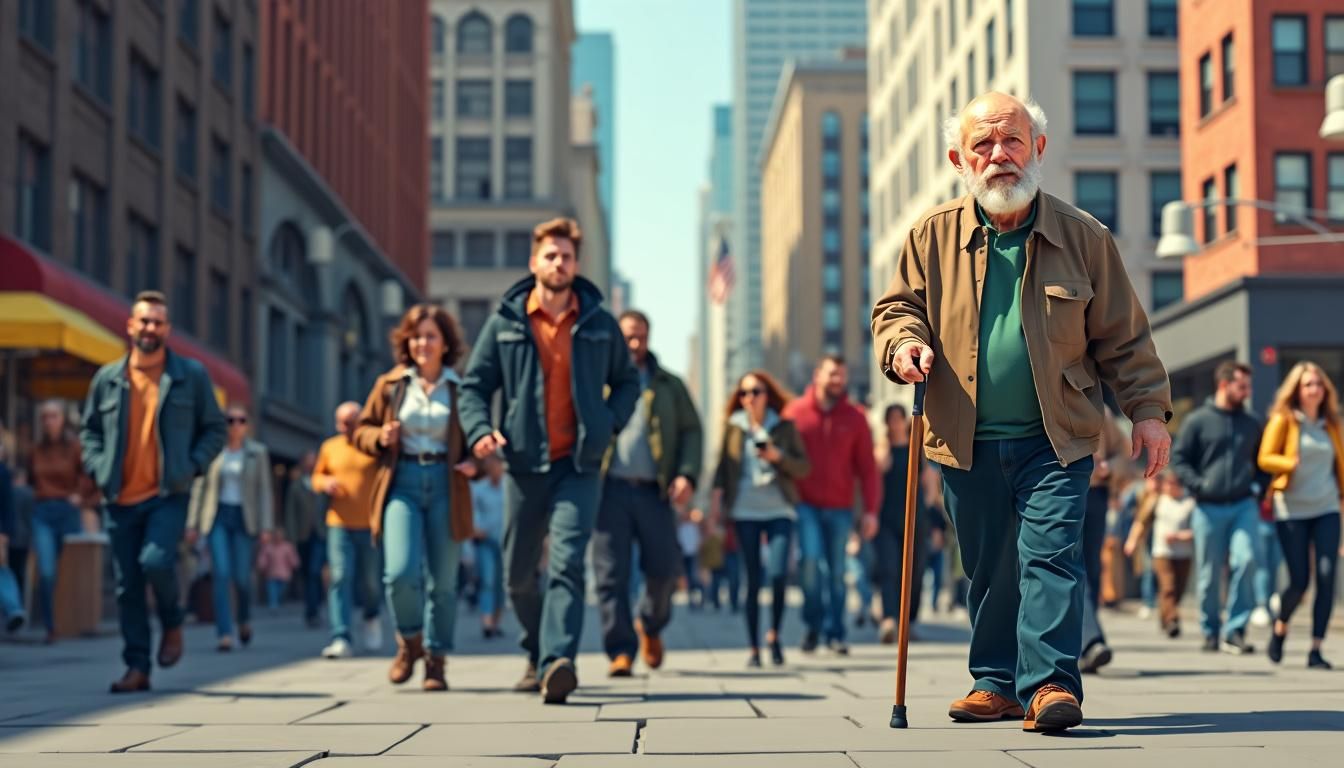Struggling with mobility can be frustrating and limiting. Did you know that choosing the right walking aid can significantly improve your independence? In this blog, you’ll learn how to select and use mobility aids like walkers and canes effectively.
Keep reading to regain your freedom!
📋✅
- Always consult a doctor or therapist before choosing a mobility aid. They will ensure you get the best fit for strength and balance.
- Adjust canes, walkers, and rollators to suit your height and grip. This helps avoid strain and makes movement easier.
- Practice using your aid indoors first. Remove obstacles like rugs to create clear walkways for safe use.
- Use aids with proper footwear that grips well. This prevents slips and improves stability while walking.
- Regularly check your mobility device for wear. Replace worn-out parts quickly to maintain safety and support.
Understanding Mobility Aids

Mobility aids help people move around safely. Common devices include canes, walkers, and rollators.
Definition and Purpose
Mobility aids help people with injuries, weakness, or balance problems. They support walking, standing, and maintaining balance.
Examples include crutches, canes, walkers, rollators, and AFOs. These devices are often prescribed during recovery from surgery or for those with chronic conditions.
Walking aids improve lives by providing the needed support.
Canes offer simple aid; walkers provide more stability. Options like quad canes have four feet for extra support.
Types: Canes, Walkers, Rollators
Mobility aids help people move safely and easily. There are different types like canes, walkers, and rollators.
- Canes:
- Single-point canes: These have one point of contact with the ground. Easy to use.
- Offset cane: Good for better balance. Helps distribute weight evenly.
- Quad canes: Have four small legs at the base. Offers more stability than single-point canes.
- Adaptations: Available in collapsible forms for easy carrying.
- Walkers:
- Standard walkers: No wheels. User must lift it to move forward.
- Two-wheeled walkers: Easier to push. Front wheels reduce the need for lifting.
- Four-wheeled walkers: For those with enough upper body strength. Suitable for smooth surfaces.
- High-wheeled walkers: Good for rough terrains. Larger wheels provide better mobility.
- Rollators:
- Rollators have four wheels and brakes. Ideal for even step lengths.
- Comes with a seat. Useful if the user needs frequent breaks while walking.
Each type serves different needs based on physical conditions and environments.
Factors to Consider When Choosing Mobility Aids
Choosing the right mobility aid can make daily tasks easier. Consider how much support and balance you need to feel safe while moving around.
Assessing Mobility Needs
Consult a doctor or physical therapist. They will check the user’s physical and cognitive abilities. This step is crucial.
Always get advice from professionals to choose the best mobility aid, says Dr. Smith.
Check upper-body strength and grip. Standard walkers can hold up to 50% of body weight. Make sure users can manage this load.
Think about physical endurance too. Rollators with seats let users rest when tired, but brakes must be on for safety.
Consider the walking environment—are there stairs, uneven paths, or narrow spaces? These factors affect which device works best: manual wheelchairs, rolling walkers, or power wheelchairs may suit different needs.
Physical Strength and Balance
Assess the user’s physical strength. Offset canes support 25% of body weight. Crutches need strong upper-body muscles since they can bear 100%. Walkers, especially front-wheel walkers, help those with Parkinson’s disease by preventing gait freezing.
Check the person’s balance ability. Rollators fit users with even step lengths. Canes and walking sticks help if only minor support is needed. Choose a device that matches their physical needs for safe and effective use.
Environmental Considerations
Stairs pose challenges. Canes or crutches work on stairs, but wheelchair ramps and stairlifts are better alternatives for safer access. In such cases, service animals can provide extra support to assist in moving through these areas.
Surface types matter. Front-wheeled walkers and rollators perform best on smooth surfaces like tile or wood floors. For outdoor use, choose knee scooters with sturdy casters to handle sidewalks.
When mobility aids match the environment, they offer better stability and ease of movement.
Next: Proper Usage of Mobility Aids
Proper Usage of Mobility Aids
Use your mobility aid correctly to stay safe and move easily. Make sure it fits you well, giving good support for balance and strength.
Adjusting Your Mobility Aid for Optimal Use
Adjusting your mobility aid correctly is crucial. This ensures safety and comfort.
- Measure for Height
- For canes, align the handle with the wrist crease when the arm is relaxed.
- For walkers and rollators, match handle height to specifications for wheelbase proportions.
- Ensure walking poles’ handles align with elbows at 90 degrees.
- Adjust Hand Grips
- Position grips so they are easy to hold without straining.
- Make sure grips are not too loose or tight.
- Secure Wheel Settings
- Check that all wheels are firmly attached and move smoothly.
- If using swiveling wheels, ensure they turn easily but stay stable.
- Verify Weight Capacity
- Confirm the aid can support your weight comfortably.
- Consult a certified orthotist if unsure about capacity limits.
- Wear Proper Footwear
- Use shoes that provide good support and grip to prevent slips.
- Test Balance Points
- Stand with the aid and check balance from all angles.
- Train on Varied Surfaces
- Practice on carpets, tiles, and outdoors for confidence in different environments.
Use these steps to adjust mobility aids like walkers and canes properly for safe use every day!
Training and Tips for Safe Mobility
Training and tips for safe mobility are crucial for using aid devices like walkers and canes. Follow the steps below to ensure proper use.
- Start with a Professional Evaluation
- Experts can assess physical strength and balance.
- Physical therapists provide customized advice.
- Adjust Equipment Properly
- Ensure the device height matches the user’s wrist level.
- Keep elbows slightly bent (15-20 degrees).
- Learn Safe Walking Techniques
- Move the cane or walker first, then step.
- For single point canes, hold it on the opposite side of the injured leg.
- Pay Attention to Hand Position
- Maintain a firm grip without over-gripping.
- Align wrists with elbows to avoid strain.
- Practice Indoors First
- Use clear spaces to practice walking.
- Remove rugs and obstacles.
- Master Turning and Sitting Safely
- Turn with small steps instead of twisting.
- Back up until legs touch the chair before sitting.
- Monitor Surfaces Outdoors
- Watch for uneven ground.
- Be cautious on wet or icy paths.
- Strengthen Supporting Muscles
- Engage in strength training exercises.
- Focus on legs, core, and upper body muscles.
- Use Stairways Carefully
- Hold onto handrails while climbing stairs.
- Place both feet on each step if needed.
- Stay Mindful of Fatigue Levels
– Rest often during long walks.
– Avoid prolonged standing without breaks.
11.Regularly Check Equipment Condition
– Inspect for wear and tear.
– Replace worn-out rubber tips promptly.
These tips will help ensure safety while improving mobility skills effectively.
The Role of Healthcare Professionals
Healthcare professionals play a key role in choosing and using mobility aids. They provide advice and customized recommendations based on individual needs.
Seeking Advice from Physical Therapists
Physical therapists help choose the right mobility device. They assess your needs and recommend the best option, like walkers or canes. This ensures a good fit for your strength and balance.
Working with a physical therapist also helps you learn proper use. They show how to adjust devices correctly. This reduces injury risks and improves mobility.
Customized Recommendations Based on Individual Assessment
Seek advice from a physical therapist for choosing the right mobility aid. They will assess your loved one’s needs, strength, and balance.
A physiotherapist ensures correct wrist, elbow, shoulder, and trunk positions. Proper form is crucial to avoid long-term issues. Custom recommendations can include canes or walkers based on the individual assessment.
Use keywords like “cognitive function,” “sports wheelchairs,” and “mobility devices” when discussing assessments. This helps in understanding specific needs effectively.
Enhancing Mobility and Independence in Seniors Through Home Modifications
Install grab bars in bathrooms. These help seniors keep balance and prevent falls. Place non-slip mats on floors to stop slips. For homes with stairs, consider stair lifts or wheelchair ramps.
They ensure easier access between levels.
Use walking aids like rollators and zimmer frames around the house. These tools support mobility and reduce strain on joints. Simple changes make a big difference in daily life for seniors, giving them more freedom at home.
Importance of Quality Sleep and Comfort for Seniors
7. Importance of Quality Sleep and Comfort for Seniors: Good sleep helps seniors feel rested, supports health, and improves mobility—read more to discover how!
How Proper Mobility Aids Enhance Sleep Quality
Properly fitted mobility aids like walkers and canes reduce pain. Less pain helps seniors sleep better at night. These aids also decrease discomfort from standing or walking too long, which means less fatigue.
Rollators with padded seats let users rest when tired. This feature reduces strain, ensuring a more restful night’s sleep. Fewer aches mean improved comfort, leading to deeper and better-quality sleep for seniors using these aids.
Recommended Products from Bed for Seniors
Adjustable beds offer comfort and support. They help seniors get in and out with ease. Electric beds with remote controls make adjusting positions simple.
Pillows for neck and back support improve sleep quality. Memory foam pillows conform to the shape of the head, reducing pain.
Adding bed rails offers safety by preventing falls. Rails also provide a steady handhold when standing up or lying down.
Quality sleep enhances mobility and overall health… Let’s look next at important tips on choosing the right mobility aids.
Conclusion
Choosing and using the right mobility aid, like walkers or canes, is key for safety. Be sure to consult a doctor or therapist. They will assess your needs and recommend what’s best.
Adjust the device properly and follow training tips for safe use. This boosts independence and improves quality of life.
For more insights on creating a safer and more accessible living environment, check out our guide on home modifications to enhance mobility and independence for seniors.
FAQs
1. What are the different types of mobility aids available?
There are many types, including walkers, canes, crutches like forearm crutches, and wheelchairs such as transport wheelchairs and motorized wheelchairs.
2. How do I choose the right mobility aid for my needs?
Consult with physiotherapists or an orthopedist to determine what fits your medical condition best—whether it’s an ankle-foot orthosis for foot-drop or a walking cane for balance issues.
3. Can mobility scooters help someone with disabilities?
Yes! Mobility scooters and electric scooters offer great support for those with disabilities like Parkinson’s disease or osteoarthritic conditions by providing ease in movement without much strain on upper extremities.
4. What should wheelchair users consider when selecting a wheelchair?
Consider factors like turning radius, camber adjustments, and whether you need an electric wheelchair or manual one based on specific needs such as stroke rehabilitation or cognitive decline.
5. Are there special considerations for blind or visually impaired individuals using assistive devices?
Absolutely… Assistive technology like guide dogs can be crucial; also consider devices designed specifically to aid those with visual impairment.
6. How do I prevent skin breakdown while using these aids?
Regularly check areas in contact with the device—especially if you have limited sensation due to hemiplegic conditions—and consult healthcare providers about proper fitting and use of cushioning materials.









